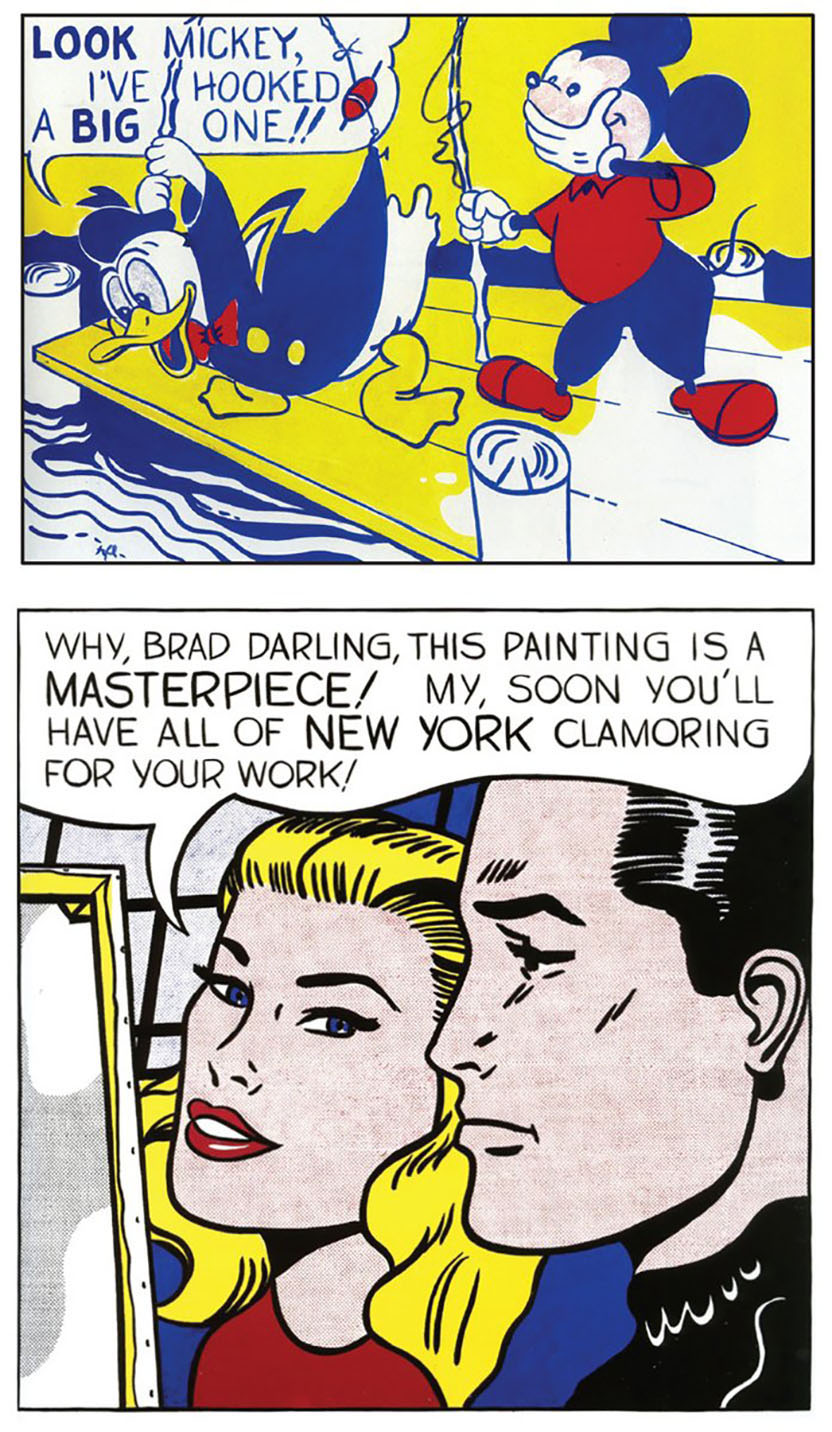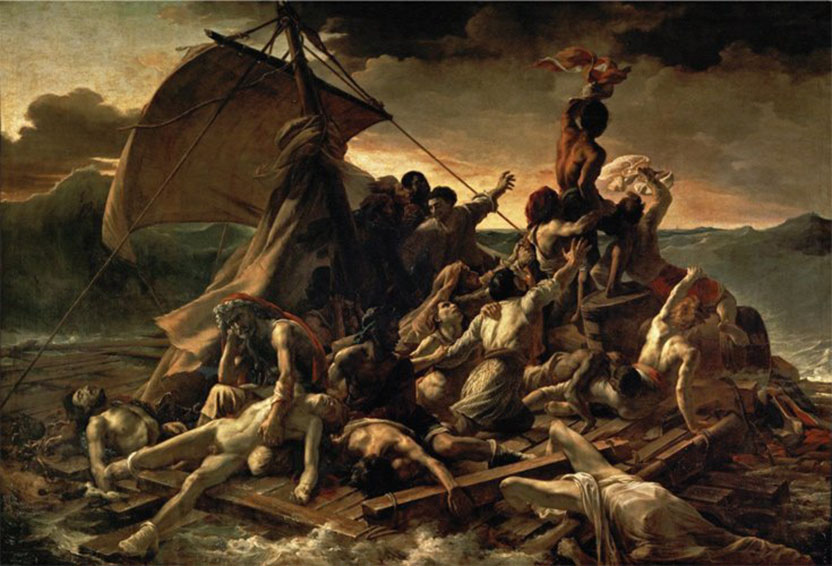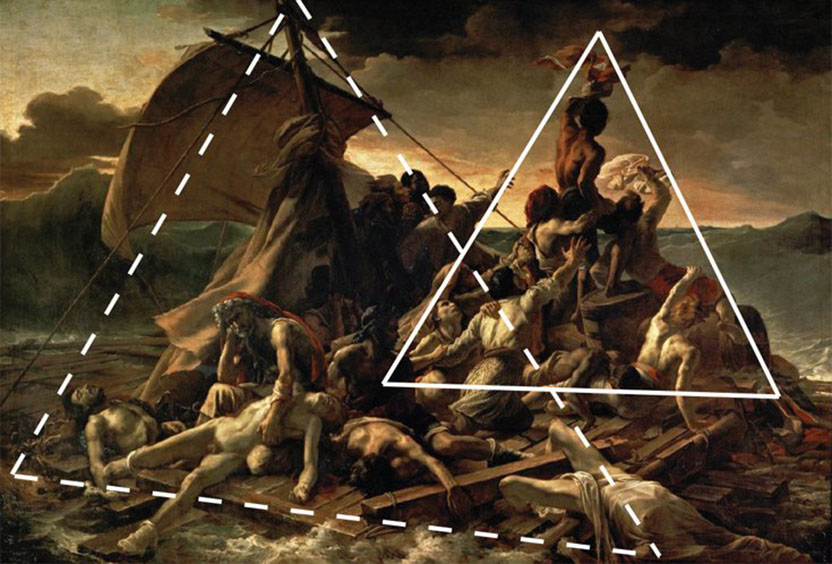 Opening remarks from the 2018 Lasker Awards ceremony
Opening remarks from the 2018 Lasker Awards ceremony
What does it take to create an artistic or scientific masterpiece? Lasker Jury Chair Joseph Goldstein considers how masterpieces hook the imaginations of scientists, artists, and the public in ways that open fields and inspire new creations.
Critics of art and philosophers of science and have long wrestled with the question of what elevates a piece of art or a set of experiments to masterpiece status. The general consensus is that great art and great science share three characteristics. The first is that the work is so original that it overwhelms us by its power. The second is that it stands the test of time. And the third is that is changes the way generations of artists or scientists think about their field. Masterpieces of art and science are like hooks that capture our imagination.
Speaking of hooks, one of the iconic paintings in modern art involves a fishhook (Figure 1, top). In the 1950s, Roy Lichtenstein worked as an illustrator for comic books in Rutgers, New Jersey. In 1961, at age 39 Lichtenstein produced a painting that shook the art world overnight. The 1950’s and early 60’s was the heyday of abstract expressionism led by Jackson Pollack, Willem de Kooning, Mark Rothko, and Barnett Newman. And then comes along a lowly cartoon illustrator who produces a non-abstract painting that featured a new art style − one that mimicked images from comic books with speech balloons and hand-painted dots.

Figure 1. Two Iconic Paintings by Roy Lichtenstein
(Top) Look Mickey. 1961. Oil on canvas. 4.0 x 5.8 ft. National Gallery of Art, Washington, D.C. (Bottom) Masterpiece. 1962. Oil on canvas. 4.5 x 4.5 ft. © Estate of Roy Lichtenstein.
This 1961 painting, entitled Look Mickey, I Hooked a Big One, launched Lichtenstein’s career as America’s first Pop artist. Notice the hand-painted, cartoon-like dots on Donald’s eyes and Mickey’s face (Figure 1, top). As evident by the pink dots in his cheeks, Mickey can hardly contain his excitement, trying hard to suppress a laugh at Donald’s blunder of hooking himself. Like Mickey, Lichtenstein can hardly suppress his excitement. He knows that he is on to something big with this revolutionary painting – a breakthrough in modern art.
Roy Lichtenstein’s Masterpiece
Within one year, Lichtenstein had hooked another big one − a solo exhibit at the famous Leo Castelli gallery in New York City, which to a scientist is like having your next 10 papers published in Cell, Science, and Nature − without any revisions. One of Lichtenstein’s paintings in the 1962 Castelli show was entitled Masterpiece (Figure 1, bottom). Masterpiece is a tongue-in-cheek joke that portends the future turmoil that Lichtenstein would stir up. The female speaks the prophetic words; “Why, Brad darling, this painting is a MASTERPIECE! Soon, you’ll have all of NEW YORK clamoring for your work!”
Lichtenstein’s words turned out to be prophetic. Masterpiece was originally sold in 1963 for several thousand dollars, and eventually ended up in the private collection of Agnes Gund, one of the leading art collectors in New York City. For the last 25 years, private collectors and auction houses clamored for Gund to sell Masterpiece. She finally gave in last year after living with the painting for 50 years. She sold Masterpiece to Steven Cohen, the infamous hedge fund manager, who paid her a whopping $165 million. Gund has used the money to create a foundation for criminal justice reform, which in itself is a masterpiece of philanthropy (Pogrebin, 2017).
During his 40-year career, Lichtenstein became one of the most celebrated contemporary artists in the last half of the 20th century. His paintings, prints, and sculptures are represented in every major art museum throughout the world. Although he died 20 years ago, his iconic signature style of comic-strip images and cartoon-like dots have had a lasting influence on present-day popular culture. Many current advertisements in newspapers and magazines continue to emulate the Lichtenstein comic book style.
A Masterpiece in The Louvre: Géricault’s Raft of the Medusa
The Lichtenstein test for a masterpiece of art is straightforward: an original work that stands the test of time and has everyone clamoring to see it. The Louvre in Paris, which is the most visited museum in the world exhibits many masterpieces that people clamor to see. Other than the Mona Lisa, the painting in The Louvre that most museum goers clamor to see is a massive canvas by the French artist Théodore Géricault entitled Raft of the Medusa (Figure 2).
Raft of the Medusa is based on a real-life event − an historic shipwreck 300 years ago that involved starvation, cannibalism, and multiple deaths (Miles, 2007). On July 2, 1816, a French ship called the Medusa ran aground on a sandbar off the coast of West Africa. Attempts to free the ship failed, and everyone had to abandon ship. Only six small life boats were available, an insufficient number to hold all 400 passengers. Only 250 people could be accommodated: the captain, his senior officers, and the wealthy. The 150 less-privileged were packed together like sardines on a raft hastily constructed from the wooden decks of the ship. The only provisions available to the 150 castaways were one bag of biscuits, two barrels of water, and a few kegs of wine. The raft soon became a floating hell of infighting, starvation, crazed behavior, and brutal murders. By the third day, cannibalism was rampant. By the time of rescue after 13 days at sea, only 15 men had survived, 5 of whom died within several days.
This tragic event involving 140 deaths became an international scandal when the press discovered that the French government had appointed an incompetent captain who had not been to sea in 25 years, had never commanded a ship, and was a favorite of King Louis XVIII (Miles, 2007). Soon after the rescue, two of the survivors – the ship’s engineer and its surgeon – wrote a celebrated account of the shipwreck and its horrors. Their gripping tale attracted the attention of the 27-year-old Géricault, who became obsessed with creating a painting that would make a provocative public statement about the tragic event (Eitner, 1973; Alhadeff, 2002).
The massive size of Raft of the Medusa (16 by 24 feet) with life-sized figures (Figure 2) differed in a revolutionary way from earlier classic works that dealt with biblical or historical themes: Raft dealt with a current event that was timely and controversial (Eitner, 1973; Miles, 2007). As the central theme for his painting, Géricault focused on the moment when a boat on the horizon was first sighted – the point at which the survivors experienced a surge of hope and optimism. As shown at the top of the painting, an African crew member frantically waves his shirt in hopes of getting the boat’s attention (Figure 2). The boat, depicted as a speck in the upper right corner, was seen by the survivors for only a half hour and then disappeared. From the delirium of joy, the survivors fell into profound despondency and grief. But two hours later, the boat reappeared and rescued the survivors.

Figure 2. Raft of the Medusa
Théodore Géricault. 1818/1819. Oil on canvas. 16 x 24 ft. Musée du Louvre, Paris.
How Géricault Rocked the Boat and Produced a Masterpiece
The brilliance of Raft is the way in which Géricault makes the viewer feel the immensity of the event. He positions the boat right into the viewer’s space, drawing us into the painting and propelling us to step onto the raft to give aid to the dying survivors. He captures the emotions experienced by the crew at the first sighting of the boat by a clever use of two interlocking pyramidal structures that contrast the gestures of the figures (Figure 3). The triangle on the left illustrates the despair and hopelessness of the dying. The triangle on the right illustrates the hope and optimism of the survivors, culminating at the apex with the African sailor waving his shirt in hopes of attracting the fleeting ship.

Figure 3. Two Interlocking Triangular Components in Raft of the Medusa.
(Left) This triangle illustrates the despair and hopelessness of the dying. (Right) This triangle illustrates the hope and optimism of the survivors.
The bodies of the men on the raft are much less emaciated than one would expect after 13 days of hunger, disease, and cannibalism. Here, Géricault is showing his true colors of romanticism. He wanted not only to depict a real life event, but he also wanted to elevate the survivors to heroic status. Thus, he composed his painting in the high style of the Old Masters, harking back to the idealized muscular figures of Michelangelo and Caravaggio.
Raft’s Influence on Prominent 20th Century Artists
In 1824, Raft was purchased by The Louvre, where it has been viewed by hundreds of millions of people over the last two centuries. It is arguably the most arresting painting in The Louvre and has stimulated many artists to produce their own variations of the painting. One such example is a work by the abstract expressionist Barnett Newman. Newman is known for his “zip” pictures in which fields of colors are painted on a large rectangular canvas and then separated by thin vertical strips of contrasting color that extended from the bottom of the canvas to the top (Temkin, 2002). The vertical strips − the “zips” − grab our attention and help define the spatial structure of his rectangular-shaped canvases (Figure 4, left).
In 1968, Newman visited The Louvre for the first time. Raft was the picture that fascinated him the most. “It’s fantastic! ….. You can feel the surge of the water, the figures tumbling out toward us” (Schneider, 2002). Newman was also especially impressed with the triangular composition of Géricault’s painting. On his return to New York, Newman painted a “zip” picture in the shape of a triangle (Figure 4, right). This was a radical departure from all of his previous rectangular-shaped paintings. Since his triangular canvas had no rectangular walls, Newman entitled the painting Jericho in reference to the Old Testament city whose walls came tumbling down. The title is also a pun on Géricault’s name. Although Jericho and Géricault are not spelled the same way, they are phonetically identical (Schneider, 2002).

Figure 4. Two Artworks by Barnett Newman
(Right) Adam. 1951/1952. Oil on canvas. 7.9 x 6.7 ft. Tate, London. (Left) Jericho. Oil on canvas. 1968/1969. 9.4 x 8.8 ft. Centre Georges Pompidou, Paris. © The Barnett Newman Foundation, New York / Artists Rights Society (ARS), New York.
Another prominent artist inspired by Géricault’s Raft is Frank Stella, known for his geometric paintings and abstract sculptures (Auping, et al., 2015). In 1990, Stella began experimenting with steel and other metals, and one of his first sculpted works was inspired by Géricault’s painting. Stella’s Raft of the Medusa is an enormous twisting grey mass of aluminum − 13 feet high, wide, and deep − that evokes the cacophony of suffering bodies clinging to a dilapidated raft constructed out of chicken wire and steel beams (Figure 5).

Figure 5. Raft of Medusa, Part I
Frank Stella. 1990. Aluminum with steel pipes, other metals, and chicken wire. 14 x 13.5 x 13.3 ft. (Left) Front side of sculpture evoking cacophony of suffering bodies clinging to dilapidated raft. (Right) Back side of sculpture showing raft constructed out of chicken wire and steel beams. The Glass House Collection, New Canaan, CT. © 2018 Frank Stella / Artists Rights Society (ARS), New York.
Stella’s immense sculpture and Newman’s triangular painting are themselves great works of art that pay homage to Géricault’s Raft of the Medusa − a painting that overwhelms us by its originality and power and one that has stood the test of time − the two cardinal characteristics that define a work of art as a masterpiece.
2018 Lasker Awards
Like Lichtenstein’s Masterpiece and Géricault’s The Raft of the Medusa, the original research of this year’s Lasker Awardees has changed the way scientists and physicians think about their particular fields.
The Lasker Basic Research Award honors Michael Grunstein (University of California, Los Angeles) and David Allis (Rockefeller University) for discoveries elucidating how gene expression is influenced by posttranslational covalent modifications of histones − the proteins that package DNA within chromosomes. For many years, scientists did not appreciate the importance of histones in gene expression. Histones were largely believed to be simply the glue that held DNA together in chromosomes. This view began to change in the early 1990’s when Grunstein initiated genetic experiments in yeast cells that demonstrated a requirement for the N-terminal tails of histones in activating and silencing genes. He then went on to identify specific lysine residues in the histone tails that turned out to be targets of post-translational acetylation. This ground-breaking work set the stage for Allis’ classic biochemical experiments in 1996 showing that a histone acetyltransferase from Tetrahymena was the homologue of GCN5, a genetically defined translational coactivator in yeast. Allis went on to show that purified GCN5 possessed intrinsic histone acetyltransferase activity that directly acetylated specific lysines in the histone tails. These biochemical findings, when considered together with the genetic studies of Grunstein, provided solid evidence for the role of histone acetylation in gene expression.
A flood of research rapidly ensued. Hundreds of scientists began working in this new field. Other histone modifications (including methylation, phosphorylation, and ubiquitination) and the enzymes that add and remove these residues were identified and characterized. The implications for biomedical science are profound: 1) histone modifications influence the activation or silencing of virtually every eukaryotic transcriptional network studied to date; 2) mutations disrupting the histone machinery underline several Mendelian disorders of development (e.g., Rubinstein-Taybi syndrome and Kabuki syndrome); and 3) histone-modifying enzymes, such as those that remove methyl and acetyl groups, are being actively pursued as therapeutic targets for a variety of malignant diseases, including solid tumors (especially pediatric gliomas), lymphomas, and leukemias. To date, only a few such inhibitors of histone deacetylates and demethylases have been approved for human use. But hundreds of clinical trials are currently in the works
The Lasker-DeBakey Clinical Research Award honors John Baird Glen (AstraZeneca, retired) for the discovery and development of propofol, the most widely used agent for induction of anesthesia in patients throughout the world. In 1972, Glen joined Imperial Chemical Industries (ICI) in London (through mergers, ICI subsequently became AstraZeneca). At ICI, he carried out a chemical screen searching for anesthetic agents that possessed three desirable properties: fast onset, short recovery time, and absence of the “hang-over” effects observed in mice administered other anesthetics. Of the thousands of agents tested, Glen selected propofol (2,6-diisopropylphenol) as a promising hypnotic.
Propofol is an oil at room temperature, which created a formidable formulation challenge that took Glen and his colleagues 10 years to solve. Success was ultimately achieved with a soybean-egg lecithin emulsion that rendered propofol in a soluble form that could be used intravenously in patients and animals. The size range of the emulsified propofol droplets (marketed as Driprivan®) refracts light, creating a milky color that led anesthesiologists to refer to it as “milk of amnesia”. Propofol was approved in 1986 in the UK, in 1989 in the US, and subsequently in 90 other countries.
In 2013 when the World Heart Organization (WHO) added propofol to the list of essential medicines, more than 190 million people worldwide had received the anesthetic. In the US in 2014, 10 million inpatient surgical operations and 17 million outpatient surgeries were performed, virtually all of which were initiated with propofol. The favorable properties of propofol – its rapid onset of action, quick metabolism by the liver, and freedom from residual effects such as nausea, vomiting, and grogginess – are largely responsible for the recent widespread increase in ambulatory surgery and outpatient diagnostic procedures, such as colonoscopy and bronchoscopy.
John Baird Glen discovered the anesthetic properties of propofol, and for more than 20 years he guided its transformation from an insoluble chemical compound to arguably the most important anesthetic since the introduction of ether in 1846. His persistent pursuit of the ideal anesthetic has improved the lives of hundreds of millions of people throughout the world.
The Lasker-Koshland Special Achievement Award is given to a scientist whose lifetime contribution to biomedical science is universally admired for its creativity, importance and impact, and whose professional statesmanship has engendered among her colleagues the deepest feelings of awe and respect. This year’s award honors Joan Argetsinger Steitz (Yale University) for four decades of leadership in biomedical science − exemplified by her pioneering discoveries in nuclear RNA, her generous mentorship of hundreds of budding scientists, and her vigorous and passionate support of women in science.
Joan Steitz has been a towering figure in the field of RNA biology for 45 years, beginning with her graduate work on the structure and function of RNA in RNA-containing bacteriophages. Her most notable scientific achievement came in 1979 and the early 1980’s when she discovered that antisera against nuclear antigens from patients with lupus and other autoimmune diseases targeted distinct entities, each of which contained a specific small nuclear RNA and a common set of proteins, which she and her student Michael Lerner named snRNPs (small nuclear ribonuclearproteins). These antibodies proved to be key reagents that revealed the earliest biochemical studies on the spliceosome, the particles that are sites of processing of pre-messenger RNA into the final mRNA. Steitz also discovered that introns, which were thought to be inert, code for snoRNAs (small nucleolar RNAs) that function in the processing of ribosomal RNA. Steitz’s most recent RNA venture has led her into the world of small noncoding viral RNAs that perturb cellular homeostasis.
Throughout her academic career, Steitz has served on multiple review panels and advisory committees for universities, research institutes, and funding agencies. She is asked to serve on these committees not because she is a woman scientist, but because of her wise counsel and broad expertise in academic and scientific matters. For 12 years, she served as scientific director of the Jane Coffin Childs Fund, which grants postdoctoral fellowships to outstanding young biomedical scientists.
Over the last 40 years, Steitz has mentored more than 200 students (undergraduate, graduate, and M.D.-Ph.D.) and postdoctoral fellows, many of whom have gone on to establish their own research careers in laboratories in the U.S. and other countries. One unique aspect of Steitz’s mentoring style is her belief that students and postdoctoral fellows who work completely independently should be allowed to publish on their own. Of the 360 publications that have originated from her laboratory, 60 of them do not include her name in the list of authors. Such generosity of this scale is indeed rare.
A discussion of Steitz’s statesmanship would not be complete without mentioning the fact that she is a role model for young women scientists. This is a responsibility that she has taken seriously throughout her career. When Steitz herself started her graduate career at the Biological Laboratories at Harvard University in 1963 and her postdoctoral fellowship at the MRC in Cambridge in 1967, there were essentially no women as role models and few if any women scientists in the laboratories where she trained. To have accomplished so much at the time she began in science certainly engenders “the deepest feeling of awe and respect.”
REFERENCES
Miles, J. (2007). The Wreck of the Medusa. (New York: Grove Press).
Eitner, L.E.A. (1973). Géricault’s “Raft of the Medusa”. (London, UK: Phaidon Press Ltd.)
Schneider, P. (2002). Flat forms, deep thoughts: Newman on Géricault. In Reconsidering Barnett Newman, M. Ho, ed. (Philadelphia, PA: Philadelphia Museum of Art), pp. 132-147.
Pogrebin, R. (2017). Agnes Gund sells a Lichtenstein to start criminal justice fund.
Alhadeff, A. (2002). The Raft of the Medusa: Géricault, Art, and Race. (New York: Prestel Publishing).
Temkin, A. (2002). Barnett Newman on exhibition. In Barnett Newman, A. Temkin, ed. (Philadelphia, PA: Philadelphia Museum of Art), pp. 18-75.
Auping, M. Weinberg, A.D., Kantor, J., and Owens, L. (2015) Frank Stella: A Retrospective. (New Haven, CT: Yale University Press).
